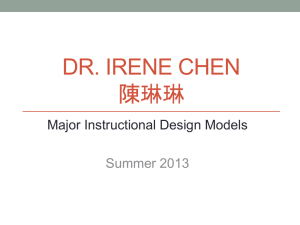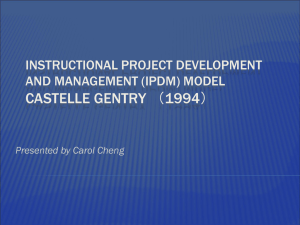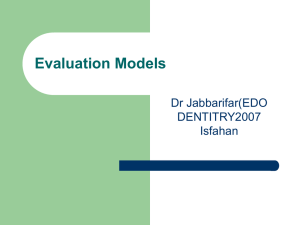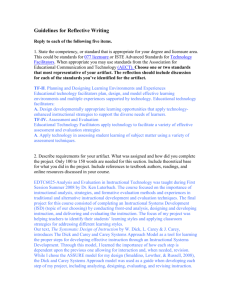Dick & Carey - Instructional Design & delivery / 2010 + Research
advertisement
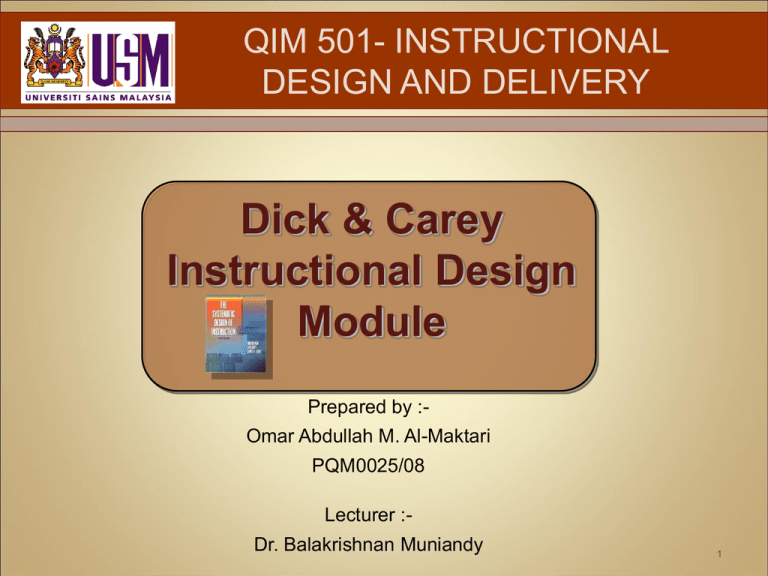
QIM 501- INSTRUCTIONAL DESIGN AND DELIVERY Dick & Carey Instructional Design Module Prepared by :Omar Abdullah M. Al-Maktari PQM0025/08 Lecturer :Dr. Balakrishnan Muniandy 1 Where did they get their PhD? Walter Dick •PhD from Penn State University in Educational Psychology •Studied with Robert Gagne' Lou Carey •PhD from Florida State University •Studied with Robert Gagne' and Walter Dick Where have they taught / worked? Walter Dick •Emeritus Professor from Florida State University •Is currently an Adjunct Assistant Professor at Penn State University Lou Carey •University of South Florida, Professor and Interim Dean •Arizona State University What things are they best known for? Walter Dick •The Dick and Carey Model for Instructional Design Lou Carey •The Dick and Carey Model for Instructional Design •She is also interested in Criterion referenced Measurement The role that rehearsal and practice tests influence performance in online learning - Such as test formatting implications - Open vs. closed book tests Dick and Carey Model Revise Instruction Conduct Instructional analysis Assess needs to Identify goals Write Performance Objectives Develop Assessment instruments Develop Instructional strategy Develop and Select Instructional materials Design and Conduct Formative Evaluation of instruction Analyze learners And contexts Design and Conduct Summative evaluation Assess Needs to Identify Goal(s) Assess Needs to Identify Goal(s) Decide what students will be able to do when they leave the course This goal can be derived from - needs assessment - a list of smaller goals - practical experience with learning - analysis of job performance - new requirements imposed on workers Learning Real World Math What would the instructional goal be if you wanted your students to help determine the area of the classroom? a) students will measure the room b) students will share a ruler c) student will use real world problem solving to apply measurement and area d) students will teach others about area and measuring Conduct Instructional Analysis Conduct Instructional Analysis Identify what is required for a student to achieve the instructional goals. What step by step skills do students need to achieve instructional goal? What is the least amount people must be able to do to be able to learn what is in the class? Analyze Learners and Contexts Analyze Learners and Contexts Simultaneously analyze. - the instructional goals of the learners - the contexts in which they will learn the skills - where they will use the knowledge Look for - learners’ current skills - current preferences - current attitudes - determine instructional setting Write Performance Objectives Write Performance Objectives Based on the instructional analysis and the entry behaviors of learners. Describe what learners will be able to do. There are 3 components: -Describe the skill or behavior. -Describe the conditions that prevail while carrying out task. -Describe the criteria used to evaluate performance. Each will have subordinate skills that should be identified. Performance Objectives: Example Terminal Objective: Given the appropriate tools, students will measure the area of a room to determine the amount of carpet necessary to cover the floor from wall to wall. Subordinate objectives: (Skill or behavior from instructional analysis) - Accurately measure perimeter of the room - Diagram the floor plan proportionately from measurements - Calculate the area using appropriate geometric formulas Performance Objectives (cont.) Conditions that prevail while carrying out task • students will use a measuring tape • students will translate measurements to a drawing • students will use equations for determining area based on the shape of the room Criteria used to evaluate performance • linear measurements are accurate to within 2“ • angles are accurately accounted for in the drawing • calculations have been made using the appropriate formulas • area calculated is within 1 square foot of the actual room size Develop Assessment Instruments Develop Assessment Instruments Instruments are based on the objectives and measure students’ ability to perform what is described in the objectives: emphasis: relating the kind of behavior described to what the assessment requires Example: - Student performance rubric for measuring the area of a room - Given any variety of room dimensions and configurations, students calculate area Instructional Strategy Instructional Strategy Plan for presenting the instruction to the learner to achieve terminal objective. - Based on analysis of what is to be taught (previous 5 steps) Decide best method for delivering the instruction. - Teacher Led, Group Led, Student Paced - Analysis of learner and skills Instructional Strategy Select of Instructional Materials Select of Instructional Materials Design and selection of materials appropriate for learning activity. - Teaching guides, transparencies, tests, computer applications, student modules, supplemental video, web pages. Decision based on the availability of existing materials and the learner. Formative Evaluation Formative Evaluation Goal is to collect data to identify how to improve instruction - one-to-one evaluation - small-group evaluation - field evaluation Not assessment of the learner, but of the instruction Formative Evaluation The methods mentioned can be difficult to apply in day to day instructional settings. They were designed for a broader view. What might be some ways an instructor can gather the formative data s/he needs to evaluate his or her instruction? Revise Instruction Revise Instruction Data from formative evaluation is analyzed to: - identify difficulties learners had in achieving objectives - relate these difficulties to specific deficiencies in instruction - re-examine validity of instructional analysis and assumptions about learner characteristics Summative Evaluation Summative Evaluation Culminating Instruction evaluation of the effectiveness of - generally outside the design process. - evaluates absolute value or worth of the instruction. - after it mets the standards of the designer. - usually an independent evaluator. Reference •http://www.opencontent.org/wiki/index.php?title=Dick_%26_Carey •http://www.gse.pku.edu.cn/jxsj/materials2/Dick%20&%20Carey.htm •http://free-booksonline.net/index.php?keyword=the+systematic+design+of+instruction&filetype=pdf &page=results •http://aritzhaupt.com/resource/perf_objs_id/background/index.html •http://www.sasked.gov.sk.ca/docs/life/ltap2in.html •Dick,Walter O. ,Carey, Lou, and Carey, Jamoes O. The Systematic Design of Instruction. Boston:Allyn & Bacon, 2004.



